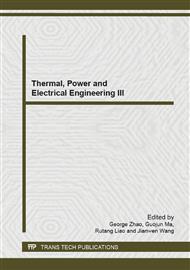[1]
J. Vienken and H. Christmann, How can liver toxins be removed? Filtration and adsorption with the Prometheus system, Therapeutic Apheresis and Dialysis, 10 (2006) 125-131.
DOI: 10.1111/j.1744-9987.2006.00353.x
Google Scholar
[2]
T.M. McCashland, B.W. Shaw Jr and E. Tape, The American experience with transplantation for acute liver failure, in Seminars in liver disease, 1996: Thieme Medical Publishers, Inc.
DOI: 10.1055/s-2007-1007255
Google Scholar
[3]
J. Rozga, Y. Umehara, A. Trofimenko, T. Sadahiro and A.A. Demetriou, A novel plasma filtration therapy for hepatic failure: Preclinical studies, Therapeutic Apheresis and Dialysis, 10 (2006) 138-144.
DOI: 10.1111/j.1744-9987.2006.00355.x
Google Scholar
[4]
J. Stange, Extracorporeal liver support, Organogenesis, 7 (2011) 64-73.
Google Scholar
[5]
B. Kreymann, M. Seige, U. Schweigart, K. -F. Kopp and M. Classen, Albumin dialysis: effective removal of copper in a patient with fulminant Wilson disease and successful bridging to liver transplantation: a new possibility for the elimination of protein-bound toxins, Journal of hepatology, 31 (1999).
DOI: 10.1016/s0168-8278(99)80322-5
Google Scholar
[6]
J. Patzer, Principles of bound solute dialysis, Therapeutic Apheresis and Dialysis, 10 (2006) 118-124.
DOI: 10.1111/j.1744-9987.2006.00352.x
Google Scholar
[7]
U. Boonsrirat, K. Tiranathanagul, N. Srisawat, P. Susantitaphong, P. Komolmit, K. Praditpornsilpa, K. Tungsanga and S. Eiam‐Ong, Effective Bilirubin Reduction by Single‐Pass Albumin Dialysis in Liver Failure, Artificial organs, 33 (2009) 648-653.
DOI: 10.1111/j.1525-1594.2009.00758.x
Google Scholar
[8]
K.L. Collins, E.A. Roberts, K. Adeli, D. Bohn and E.A. Harvey, Single pass albumin dialysis (SPAD) in fulminant Wilsonian liver failure: a case report, Pediatric Nephrology, 23 (2008) 1013-1016.
DOI: 10.1007/s00467-008-0761-x
Google Scholar
[9]
P. Krisper and R.E. Stauber, Technology Insight: artificial extracorporeal liver support—how does Prometheus® compare with MARS®?, Nature Clinical Practice Nephrology, 3 (2007) 267-276.
DOI: 10.1038/ncpneph0466
Google Scholar
[10]
S. Sen, R. Mookerjee, N. Davies, R. Williams and R. Jalan, Review article: the molecular adsorbents recirculating system (MARS) in liver failure, Alimentary pharmacology & therapeutics, 16 (2002) 32-38.
DOI: 10.1046/j.1365-2036.16.s5.5.x
Google Scholar
[11]
I.M. Sauer, M. Goetz, I. Steffen, G. Walter, D.C. Kehr, R. Schwartlander, Y.J. Hwang, A. Pascher, J.C. Gerlach and P. Neuhaus, In vitro comparison of the molecular adsorbent recirculation system (MARS) and single-pass albumin dialysis (SPAD), Hepatology, 39 (2004).
DOI: 10.1002/hep.20195
Google Scholar
[12]
J.F. Patzer and S.E. Bane, Bound solute dialysis, ASAIO journal, 49 (2003) 271-281.
DOI: 10.1097/01.mat.0000065378.73558.83
Google Scholar
[13]
W. Ding, S. Heimfeld, J. -A. Reems, D. Gao and X. Zhou, A steady-state mass transfer model of removing CPAs from cryopreserved blood with hollow fiber modules, Journal of biomechanical engineering, 132 (2010) 011002.
DOI: 10.1115/1.4000110
Google Scholar
[14]
Y. Pei, Y. Sun, Y. Xu, G. Zhao, D. Gao and W. Ding, A theoretical ultrafiltration model for albumin-bound toxin dialysis, in Complex Medical Engineering (CME), 2013 ICME International Conference, 2013: IEEE.
DOI: 10.1109/iccme.2013.6548306
Google Scholar
[15]
J.F. Patzer, S.A. Safta and R.H. Miller, Slow continuous ultrafiltration with bound solute dialysis, ASAIO journal, 52 (2006) 47-58.
DOI: 10.1097/01.mat.0000196524.36394.0d
Google Scholar


